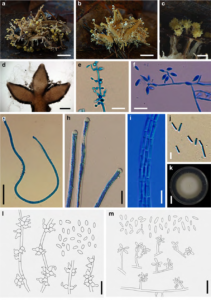Beauveria loeiensis Luangsa-ard, Tasan., Khons., Thanakitp. & Somrith., in Ariyawansa et al., Fungal Diversity: 10.1007/s13225-015-0346-5, [126] (2015)
Index Fungorum number: IF551324; Facesoffungi number: FoF00977
Etymology – named after the type locality.
Holotype – BBH 18836
Parasitic in arthropods (Orthoptera, Gryllacrididae). Sexual morph: Stromata on body and leg joints of adult Orthoptera several, scattered, simple or branched, cylindrical to enlarged at the apices, yellowish cream, 1–3 mm long, with perithecia in small clusters (20–30) at the apices. Perithecia narrowly ovoid with acute apices, 650– 710×280–320 μm, superficial and crowded at the apex. Asci cylindrical, 370–450×5 μm, ascus caps 2.5 μm. Ascospores filiform, breaking into 32 part spores, 5–10× 1 μm. Some of the specimens are accompanied with the Beauveria asexual morph. Asexual morph: Synnemata arescattered on the body and legs of the host, cream to yellowish brown, smooth-walled, 2–6 mm in length, the upper portion mealy with oblong-ellipsoid conidia, some concave to one side and flattened or convex to the other (2–4×1.2−1.5 μm), white; conidiogenous cells round or flask-shaped, producing conidia sympodially on divergent denticles, in whorls of two or more or singly, scattered along the hypha.
Culture characters: Colonies on PDA are relatively fast growing, reaching 10 mm diam. after 14 days at 25 °C; circular, dense, at first white and floccose, becoming cream to yellow cream in the center with age; conidiation starts as early as 12 h after inoculation. Conidiophores arise from the agar, white, smooth-walled, conidiogenous structures up to 12.5 μm long, cylindrical or narrowing at the tip producing ellipsoidal to cylindrical conidia (3.5−6×1.5−2 μm) with rounded ends.
Material examined – THAILAND, Phureua Mountain range, Loei Province, Chatchanat Farm, isolated on cricket on the leaf litter, 26 September 2006, K. Tasanathai, S. Mongkolsamrit, B. Thongnuch, R. Ridkaew, P. Srikitikulchai and C. Chuaseeharonnachai (BBH 18836, holotype); ex-type living culture, BCC 23107.
Other specimens examined: THAILAND, Loei Province, Chatchanat Farm, on Gryllacrididae, Orthoptera in forest habitat, (17° 27′ 17.99″N, 101° 21′ 47.99″E), BBH 18831 (BCC 23101), BBH 17765 (BCC 23102), BBH 17766 (BCC 23103), BBH 18834 (BCC 23105), BBH 18835 (BCC 23106) 26 September 2006, K. Tasanathai, S. Mongkolsamrit, B. Thongnuch, R. Ridkaew, P. Srikitikulchai, and C. Chuaseeharonnachai. BBH18832, (BCC23242), BBH18833, 26 September 2006, K. Tasanathai, S. Mongkolsamrit, B. Thongnuch, R. Ridkaew, P. Srikitikulchai, and C. Chuaseeharonnachai; Kaeng Krachan National Park, (12°54′
24.00″N, 99°38′53.00″E), BBH 15059, (BCC 21108), 14 November 2005, K. Tasanathai, B. Thongnuch, R. Ridkaew

Fig. 1 Beauveria loeiensis (holotype) a, b Fungus on host c Clusters of superficial perithecia on host d Perithecia e Phialides on host f Phialides on PDA g Mature ascus h Asci and asci cap i, j Part-spores k Colony on PDA after 20 days l Conidiogenous structures on the host m Conidiogenous structures on PDA. Scale bars: a–b, k=10 mm, c= 2 mm, d=200 μm, g=50 μm, e–f, l–m=10 μm
